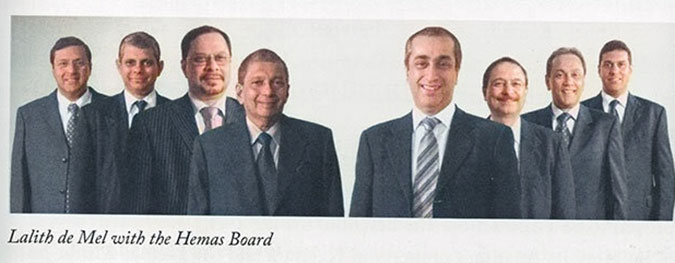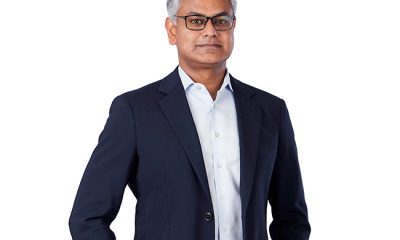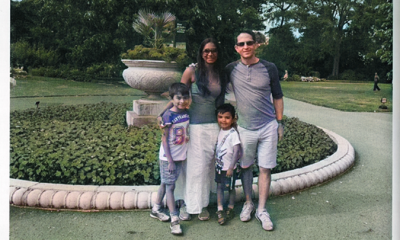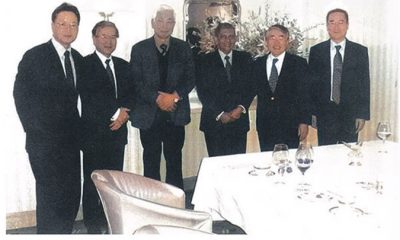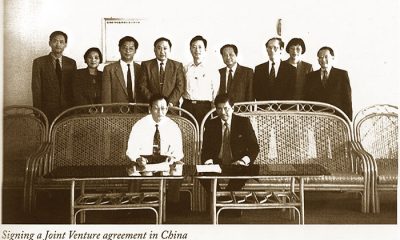Features
On to the private sector – JKH, Hemas and Schaffter company

Working simultaneously with state and private sectors
(Excerpted from the autobiography of Lalith de Mel)
About the time I joined the SLT Board, Ken Balendra, the Chairman of John Keells Holdings, invited me to join the Board of his company. That was the start of my working simultaneously with the private sector and the State sector. Ken was a strong personality and could by himself enforce the disciplines of good governance. He was due to retire and he felt, and I think correctly, that he should leave JKH with a more formal structure to ensure good governance. He appointed three Independent Directors, S. Easparathasan, Franklyn Amerasinghe and myself, and later Tarun Das.
There was a major issue with the management arrangements at JKH. It had a serious ‘Parents-and-Children’ syndrome. The Executive Directors managed their segments of responsibility, like a chief executive. So they became the children managing the business. But they were also in corporate terms the parent responsible to the Board for this segment’s activity. So in effect they reported to themselves for their area of responsibility. So they were both parents and children.
In management terms this was a bad model and has been extensively discussed in the literature. I found a very good book on the subject and insisted that they all read it. The JKH team comprised nice and intelligent people and they were prepared to think positively about change where it was necessary. It was a pleasure working with this group, and they appreciated what I did for them.
They accepted that the business units should have a head reporting to the Directors – a separation of parents from children. The parents would be accountable to the Board. This is the classic management model and I was glad to take JKH down this road.
JKH had an entrepreneurial culture. I think this heritage came from Mark Bostock’s time. Instinct had played a role in selecting acquisitions. Persuading them to adopt hurdle rates and cash-flow paybacks helped to test acquisitions and to dispose of some bad acquisitions. When I was on the Board, the LMS (Lanka Marine Services) acquisition came up for discussion. The financials were good. I had a Shell background in my youth and knew something about petroleum products and bunkers.
I discreetly asked Susantha Ratnayake (who was promoting the acquisition) whether he or JKH knew anything about the bunker business. He said, `No, but Sir, it is not rocket science and we can learn it.’ He had acquired some of the JKH entrepreneurial culture. It was brave of him to persuade the Board to buy a business without knowing the business. They bought it and it was very profitable.
Ken Balendra knew his team better than anybody else and had selected Lintotawela to succeed him. He was a finance man and perhaps Ken thought it best to have a numbers man to preside over his entrepreneurial troops. I did not think he was quite JKH style and thought that Susantha was the driving force in the business. After I left the Board, whenever I met Susantha I told him that he was developing a stoop by carrying the business on his shoulders (he turned a light shade of pink and hated me for saying it). Subsequently Susantha Ratnayake became the very successful Chairman of JKH.
LEAVING JKH
I met Abbas Esufally, I think it was at the Golf Club, and he said Hemas was debating whether to go public (with a listing on the CSE), and he wanted me to help them to decide, and if they went ahead to help them through the process. I agreed to meet them and talk about it as I held the view, and still do, that a private sector economy would survive best if all the big companies went public, so that the wider public could also benefit from their success, and this would create inclusive growth.
Eventually I agreed to help Hemas, and I told JKH about it. Lintotawela was unhappy and I could not be on the JKH Board and the Hemas Board. He saw a conflict of interest because JKH was in Hotels and Serendib had three hotels, one in Sigiriya and one in Waikkal, where JKH had no hotels, and one three-star in Bentota where JKH had the five-star Bentota Beach Hotel. The JKH team tried to persuade me to dump Hemas and stay with them, but I felt I had done my bit for JKH and it was an interesting challenge to take Hemas public.
I resigned from the JKH Board to join Hemas. The JKH Directors continued as friends and still Susantha very kindly invites me for dinner from time to time.
Investing in Serendib and joining Hemas
Even during the dark days of the war, when tourist arrivals were poor, I believed that in the long-term tourism would be our oil well. To get closer to the industry I wanted to make an investment in a hotel company. Through a mutual friend I met Abbas Esufally and with his help bought the shares of a Director of Serendib Hotels, who was retiring. It was a relatively modest investment but it got me to the top three non-corporate individual shareholders and I was invited to join the Board. I also invested in the quoted Serendib subsidiary companies Sigiriya and Dolphin.
This gave me a good and continuous rolling insight of the tourism industry. I had always been interested in tourism as a good industry for developing countries. This close-up picture of the hotel industry was helpful in developing my knowledge. I was happy to be on the Board.
Serendib was a fairly unstructured business and I endeavoured to help the management develop relevant business processes. I encouraged the management to develop Serendib as a brand and to leverage the Bawa connection.
It was one of Geoffrey Bawa’s early hotels. It had been heavily influenced by 18th century Dutch architecture. The facade viewed from the beach had a remarkable resemblance to the well-preserved Dutch building in Pettah.
The hotel put together a Bawa room to illustrate and leverage the Bawa link. After Srilal Miththapala, the enthusiastic Manager in the early phase, we had Ranil De Silva, a very experienced modern Manager. I was happy to be an active and involved member of the Board, and saw the hotel expanding both physically and in quality and as a shareholder I was pleased that it also was a steady, profitable hotel.
Abbas Esufally, one of the four major shareholders of Hemas Holdings, was Chairman of the Company. He was perceptive of the issues relating to tourism, was a pleasure to work with, and I enjoyed working with him, for many years.
The Minor Group, a big international hotel group with a base in Thailand, had expressed an interest in some form of collaboration. This proved to be a distraction. The Serendib management was heavily involved in building its Anantara property in Kalutara and the Hemas Minor Joint Venture hotel in Tangalle. The joint venture with Minor never happened and Serendib had to consider a life without Minor. This was a new strategic challenge. I did not stand for re-election.
Hemas was owned by four Esufally cousins. Each managed a piece of the business, with freedom to do as they pleased. They had the same cars and same salary and lived down the same road. A high comfort zone.
My role was to explain the process, advantages and consequences of becoming a public company. The big concern was whether the public would buy the shares of a firm in Bristol Street owned by four Borah cousins. I was convinced that a properly-constructed public offering would succeed.
The daunting question for them was whether to remain private in their comfort zone or to release the value by going public and accepting all the restrictions on freedom that came with it. The prospect of becoming billionaires won. But it proved to be a hard struggle to get them to keep their part of the bargain and accept the restrictions on their freedom as a public quoted company. I agreed to come on the Board and lend my name to the public issue and the financial advisers were confident that the issue would be fully subscribed. It was.
Public company
It had three Independent Directors, and I was the Independent Chairman. I tried to perform two roles. To give them the benefit of my management experience and be a mentor to develop the management skills of the company and as Chairman to establish the good governance practices of a public company and create the corporate structures that would help optimize shareholder value.
The first problem
To complacently accept less than the best skills available was not compatible with the obligations of a Chairman, the custodian of the public shareholders’ interests. This created problems. The four family shareholders were all intelligent and educated. In the management structure of any good company, that only gets one to the starting gate. What they all, including Hussein, lacked was good business experience gained by working elsewhere under outstanding managers and a high quality management education.
It was a struggle to get them to accept that they should relinquish the Managing Director type of roles they performed, and to bring in first-class management so as to optimize shareholder value and for them to move to a Non-Executive Chairman type of role.
I can well understand that they would have resented me for pushing them to give up their roles, but probably reluctantly accepted that it was in the best interest of protecting the billions of value they owned in shares. Abbas Esufally was charming and gregarious, looked at it all in a very mature fashion, and took it all in his stride in the interests of developing shareholder value. His only concern was fashioning a useful role when he gave up his executive line job.
The biggest block
Hussein Esufally was the biggest block to creating a proper Board-managed company. Transition from a family firm to public company meant the major roles of managing the business, which were all in Hussein’s hand as the CEO of the family business, had to be vested in the Board headed by the Chairman.
He resented it, but had to accept, for example, that there had to be a Remuneration Committee, an Audit Committee, and that annual plans and investment proposals, etc. had to be approved by the Board. Good governance processes remain cosmetic until you give them teeth, and giving them teeth was not easy.
He saw this as a move of authority from him to me and did not like it, as it affected his ego. His reaction was to endeavour to diminish the image of the Chairman. He did not provide the Chairman with an office or a secretary, let alone a company car or entertainment allowance. When I insisted on an office, he gave me a little cubicle behind a secretary.
This undermined my ability to interact with the senior management as I had no proper venue to meet them and it was not in keeping with the image of a chairman of a public company to ask managers to meet the Chairman in his shoebox! When he had decided that he would be the next chairman, a grand office was created. I was like a shadow hovering relentlessly, pursing the reduction of his powers and creating a proper Board-managed public company.
Snakes and ladders
I thought that over the years I had convinced the family that the best method of protecting their wealth was to be a proper public company with an independent chairman and an experienced management team with a good track record managing it.
Steadily over the years we climbed up the ladder, rung by rung. I thought I had convinced them that the two sacred pillars of a good public company were an independent chairman and an excellent and experienced CEO.
When it was time for me to retire, sadly both these pillars were ignored. It was case of whizzing down a snake at the end. Hussein had decided to be Chairman. An end to independent chairmen at Hemas.
The choice for Chief Executive was Enderby. When I was a Director of CDC Plc in the UK, Donald Peck was Managing Director South Asia and Steven Enderby was a member of his private equity team. Steven Enderby had never managed a business as an executive CEO.
CDC was in private equity operations and Enderby could perhaps use his contacts from private equity days to get some funds to buy Hemas in the market and thereby help the share price. Steven is a friendly, charming and intelligent person but had no general management experience to bring to the party. After a long career of success in my endeavours, this is the one big blot of failure.
Fortunately for shareholders, Hemas had some good people, Malinga Arsakularatne had done an excellent job as Head of Finance. There had been many good marketing men in FMCG. If Hemas was prepared to have a CEO with great potential but no previous CEO experience in a big business, the very talented Kasturi Chellaraja Wilson would have been an excellent choice.
In addition to being appointed, there was also something in the air about Steven Enderby wanting to buy a large block of shares at a discount. I don’t know whether this ever happened. I did not want to be a party to the decisions regarding the Chairman and CEO. I said I must retire from the Board before these decisions were made and did so.I did not leave Hemas with the gratitude of the family but I think it was with their resentment.
Trading in bonds
Dinesh Schaffter wanted my help and guidance on developing a conglomerate of businesses he had put together. I said I would have a good look at his business and see whether I could add value. Ksathriya, as it was called, was managed by a small team of highly-paid managers.
I was appalled by what I saw in the numbers. They had made a number of bad acquisitions and were in the throes of making another, a supermarket chain, which had all the signs of another bad acquisition. Ksathriya was kissing distance away from bankruptcy. The task was not growth but restructuring for survival.
The management team was discontinued. Manjula Mathews, Dinesh’s sister, who also had a financial interest, joined the team to salvage what we could from this business which was in dire straits. This was the beginning of a long association with the Schaffters and their businesses. Ksathriya could not be saved as an ongoing business and all commercial operations dwindled down and were wound up.
Dinesh Schaffter was the eternal entrepreneur and his philosophy was ‘if one failed, look for another’. Ksathriya was reborn as Dunamis. Tucked away within it was a piece of relatively neglected business, which was high risk but interesting. The business called First Capital was a licensed bond trader and could trade in Government securities. So I joined First Capital as a mentor, ended up on the Board, and eventually was Chairman.
Trading in Government securities, to put it very simply, was to buy at the Central Bank auctions with money borrowed from the Banks and sell on at a profit but at very thin margins of profit. It was volume that gave one a meaningful profit, but volume meant high debt. It was a difficult business of predicting trends in interest rates and backing the judgment with high-risk trading.
Good governance was paramount. Processes had to be put in place to ensure good governance of trading and good management and they had to be rigorously enforced. The industry was heavily regulated. Compliance was vital as failure could result in losing the license to trade, which would mean the end of the company.
A compliance team was established but it was necessary for the Board to keep this activity under continuous review. The other area to be managed with utmost care was the management of risk and there was a Risk Management Committee. It was compliance to protect the license and risk to protect the shareholders’ money.
There were the other corporate bells and whistles essential in a public company, like a Remuneration Committee and an Audit Committee, and these were established. Around First Capital, there was another conglomerate developing. Wealth management, investment funds and a stockbroking firm. Good processes were established to facilitate their development.
The Schaffters, Manjula and Dinesh, were delightful people to work with, for many reasons. They were both very bright, there was always a chuckle even when contemplating dire circumstances if things went wrong. Never a risk of rumbling egos. If they had any, they never brought them to work. They always appreciated what I did for them. Whenever I met their father, Chandra Schaffter, he never failed to thank me for helping his children.
The thought of retiring from all work was hovering in my mind. A difficult regulatory development provided the exit. Stringent regulations were introduced about related party transactions. In close-knit conglomerates this was a problem and created the need to unravel them and to create new arrangements that complied with the regulations. At the tail-end of my career I had little appetite to take this on, and I had a good solution.
I had brought two excellent finance people on to the Board, Minette Perera and Nishan Fernando. They had both worked in companies where I was Chairman. Minette at Reckitts and Nishan at SLT. They were appointed to a Related Party Transaction Committee. After watching over it for a few months I knew it was in safe hands, and as I had done my bit for the Schaffters over the years I thought it was in good order not to stand for re-election, and brought the curtain down after a 55-year career.
Features
Putin in Modi’s India

That was no ordinary greeting; on the frosty evening of last Thursday, Indian Prime Minister Modi embraced Russian President Vladimir Putin in a bear hug at Delhi airport and, within moments, presented him with a copy of the Bhagavad Gita in Russian. The choice of gift was laden with symbolism—echoes of Robert Oppenheimer, who drew profound philosophical reckoning from the same text, declaring, “Now I am become Death, the destroyer of worlds,” after witnessing the first atomic explosion. Was Modi signaling the weight of nuclear-age responsibility to Putin, or was this a deliberate affirmation of India’s comfort in maintaining ties with a pariah state under global sanctions?
The streets of Delhi, festooned with Russian and Indian flags and dominated by colossal billboards of Modi and Putin, suggested more than ceremonial protocol—it was pageantry of influence, an audacious statement of India’s strategic independence. In that gesture, New Delhi appeared to assert that moral judgment from the West would no longer dictate its choices, and that the Indo-Russian relationship, forged during the Cold War and hardened by decades of defence dependence, remains a pivot capable of unsettling the established order in South Asia and beyond.
Putin’s first visit to India in four years, coinciding with talks in Washington over a possible Ukraine peace framework, came at a time when New Delhi is walking an increasingly delicate tightrope between Moscow and Washington. The optics of the visit—from ceremonial receptions at Rashtrapati Bhavan to summit talks at Hyderabad House—reflected not merely diplomacy but an overt projection of influence. Modi’s presentation of the Bhagavad Gita in Russian was emblematic: a centuries-old text of dharma and duty, layered with the moral weight of choice, now inserted into the theatre of high-stakes realpolitik.
Putin himself, in an interview with India Today, described India as a “major global player, not a British colony,” praising Modi as a “reliable person” who does not succumb to pressure. These words, spoken against the backdrop of US sanctions, EU manoeuvres to leverage frozen Russian assets for Ukraine, and growing Chinese assertiveness, highlight India’s determination to claim agency in a multipolar world where Washington and Brussels no longer set the rules unilaterally.
Historically, the Indo-Russian relationship has oscillated between strategic necessity and opportunism. Declassified CIA documents from the 1980s reveal the delicate dance India played with the USSR during the Cold War. Indira Gandhi’s approach, as the CIA observed, was staunchly nationalist and fiercely protective of India’s regional supremacy. The United States feared that India’s policies towards its neighbours, coupled with its Soviet alignment, could destabilize South Asia while simultaneously granting Moscow a strategic foothold. Today, the echoes of that era reverberate: New Delhi remains Moscow’s top arms buyer, leases nuclear-powered submarines, and maintains energy ties that have drawn ire from Washington, while ensuring that its engagement with Russia does not fully alienate the United States or Western partners.
What is important to see here is the economic metrics. India-Russia trade in 2025 is estimated at roughly $18 billion, heavily skewed in Moscow’s favour due to energy imports, while India continues to negotiate with the United States to mitigate punitive tariffs, including a 25 percent secondary tariff imposed over India’s purchases of Russian oil. Both nations aim to expand bilateral trade to a target of $100 billion by 2030, a goal that falls just two years after the next general elections, when Prime Minister Modi is widely expected to contest again despite the symbolic 75-year age limit for party leadership—a restriction that has largely been treated as political theatre and quickly forgotten. It is worth noting that India’s trade deficit with the US has ballooned to approximately $42 billion in the last fiscal year, reflecting both structural imbalances and the impact of these punitive measures. Remittances provide a partial counterweight: Indians working in the US send home over $90 billion annually, dwarfing Russian remittances, which are negligible in comparison. This indicates that while India faces challenges in trade metrics, its diaspora injects substantial financial resilience into the economy.
The summit also highlighted defence collaboration in stark terms. India’s $2 billion lease of a Russian nuclear-powered attack submarine, with delivery scheduled for 2028, signals an unprecedented deepening of underwater capabilities. The vessel, unable to enter combat under lease terms, is intended to train crews and refine India’s nuclear submarine operations—a critical step for strategic deterrence in the Indian Ocean amid rising Chinese and US naval competition. Russia, despite sanctions and Western pressure, continues to sustain a military-industrial complex capable of producing tanks, missiles, and drones at accelerating rates. As reports from Ukraine’s Center for Analytical Studies and Countering Hybrid Threats indicate, nearly half of Russian defence enterprises remain unsanctioned, exposing the limitations of Western punitive measures. In this context, India’s engagement with Russian defence capabilities is both a practical necessity and a symbolic assertion that strategic imperatives can outweigh Western orthodoxy.
Sanctions, however, remain a persistent backdrop. The European Union, under Ursula von der Leyen, has attempted to deploy emergency measures to convert frozen Russian assets into loans for Ukraine, challenging EU treaties and raising the prospect of legal confrontations with countries such as Hungary and Belgium. The United States, meanwhile, has explored using the same assets in US-led investment frameworks to facilitate reconstruction or political leverage. India, observing these efforts, has maintained a stance of strategic neutrality—resisting calls to condemn Russia while advocating for diplomacy, and emphasizing that selective sanctioning by Western powers is inconsistent and self-serving. Putin, speaking to India Today, noted that Washington and Moscow presented papers in parallel but reached no compromises, and highlighted that over 90 percent of Russia-India transactions are conducted in national currencies—a subtle yet potent challenge to dollar dominance.
The optics extend into nuclear and high-tech collaboration. India is developing nuclear-capable submarine-launched ballistic missiles, advancing its underwater fleet, and exploring high-tech partnerships with Russia, recalibrating the strategic environment in South Asia. Putin’s rhetoric that “Kiev is the mother of all Russian cities” and his framing of Russia’s role in eastern Ukraine resonate with historical narratives of great power assertion, yet they also serve as a conscious projection of strength aimed at partners like India. Modi’s reception was far from ceremonial; it underlined a shared understanding that global power is increasingly multipolar and that alliances must be flexible, resilient, and insulated from Western censure.
Even in the economic sphere, India challenges conventional assumptions. While the trade deficit with Russia persists due to energy imports, India’s broader engagement with global markets—including remittances from its diaspora and ongoing negotiations with the US—allows New Delhi to balance sovereignty with strategic interest. Putin’s discussions emphasizing bilateral trade growth, high-technology collaboration, and future energy projects further solidify this interdependence. The bottom line is clear: the India-Russia partnership, far from being a relic of Cold War calculations, has evolved into a sophisticated framework for navigating sanctions, economic competition, and regional security challenges, and it may yet redefine the balance of power in South Asia.
by Nilantha Ilangamuwa
in New Delhi
Features
Lalith Athulathmudali: an exceptional minister who managed time and got the best out of his team

His hallmark was efficiency, wit and much more
I would now like to devote some space to Minister Athulathmudali and how he ran his Ministry. His was a disciplined approach to work. Everyone knew that he was very happy in his previous portfolio of Trade and Shipping, where in addition to numerous achievements he had steered through Parliament path breaking legislation to modernize these sectors. The Port Authorities Act; the new Companies Act; the Intellectual Property Act; the Consumer Protection Act; and many others were evidence of significant productivity.
Therefore, many thought that he would be unhappy in his new portfolio. In fact some one asked him this question one day, in our presence. His reply was characteristic of his professional approach to work. He said that the Ministry he was given did not matter. Whatever Ministry, hie was given, it was his duty to comprehend the issues and productively address them. “Even if I was given the Buddha Sasana Ministry, I will still find plenty to do to improve matters,” he concluded. This spirit and this approach illuminated the work of the Ministry. I have yet to see anyone, apart from a Minister, who budgeted time so rigorously.
He desired to pack value to every passing minute. He was the only Minister, I knew in nearly 37 years of public service, who always fixed a starting as well as a finishing time for all his meetings. Perhaps the only meeting where he could not have a firm grip on time was the Cabinet meeting. There were no welcoming speeches or votes of thanks in his regime. He came to a meeting and got straight to the point. He despised visibly the sycophantic panegyrics which had become a part of the culture of welcoming speeches and votes of thanks.
He used to say publicly that we had become a society of humbugs and lick-spittles. He wanted none of it. With him performance was all. You either kept to his pace of work and requirement for relevancy in all matters, or you were quickly marginalized. To some of us, who had cultivated a life long habit of hard work, and of being up to date, it was both pleasurable and at times even exhilarating to work with him. The lazy or the unprepared had to encounter him with considerable dread as a companion. Not that he was ever harsh. He did not raise his voice, or even scold. He had the capacity to marginalize and dismiss you with wit and verve.
Mr. Athulathmudali just did not have time for pedlars in excuses or shirkers. Again, this did not mean that he expected us to be superhuman. He was a quick judge of the genuine and the credible. He was well aware that those who work hard and take scores of decisions a day would sometimes make mistakes. That was to be expected, provided however that they were not due to gross negligence or egregious blunder. Reasonable errors of judgment were a different matter provided of course they were not too frequent. With him all the officers knew what to expect.
I often wondered whether in Mr. Athulathmudali’s case, his intense preoccupation with time had something to do with the near death experience he suffered when he was seriously injured in a grenade explosion in Parliament. Those who rushed him to hospital on that day said that they could feel no pulse. He himself later said that he went beyond and then returned. My opportunity to work closely with him as Secretary was after he had undergone this experience. Everyone knew of course that he was a quick decision maker and an efficient Minister even before this incident. But I have no means of telling whether this obsession with time to this degree was a post incident reaction or not.
Linked together with this preoccupation with time was the intensity of his desire to be completely up to date both on matters relating to the subject areas of his Ministry as well as all aspects of current affairs. He regularly read the major current affairs magazines and journals. He read rapidly and was therefore able to pack in more into his reading time. He almost always read in the car, a habit which I shared with him. On one occasion, on a trip outside Colombo, he invited me to join him in his car for the journey back. After about half an hour’s conversation, both of us settled down to read, for I too always carried a stock of reading matter in the car. Some cannot read in a moving vehicle. They get nausea if they try. I have been fortunate that this does not happen to me, because I have finished whole books, whilst commuting to and fro.
The alternative would have been vacantly gazing on familiar sights. To round up this aspect of Mr. Athulathmudali’s character, one thing more needs to be said. He was the only person I knew who nearly always carried a World band radio in his brief case. He used to briefly interrupt meetings some times in order to catch the latest news bulletin from the BBC, Voice of America or some other station. Such was the importance he placed on being completely up to date. I hope all these do not convey an image of some grim automaton. That would be far from the truth.
His was a complex character. It was in fact fun to work with him. We got through discussing serious subjects with a considerable degree of wit, repartee and light banter. He encouraged criticism and dissent. But you had to have an arguable point and be prepared to sustain the argument with him. He also insisted on politeness in conversation and in argument. I myself as well as some of the senior pfficials of our team regularly argued with him. Both sides enjoyed this.
Mr. Athulathmudali created the conditions that made us feel comfortable arguing with him or dissenting. In this process, we were treated as equals. Mrs. Bandaranaike was another one of those persons who welcomed an argument with her officials, and did not try to stamp down dissent. She too, like Mr. Athulathmudali had high regard for such officials, a regard which she carried with her well past her own political vicissitudes.
Main areas of focus
Mr. Athulathmudali focused on two main areas. The first area related to the numerous operations of the Ministry. These Included a close and detailed pursuit of the progress of the two main paddy crops in the seasons of Maha and Yala; the review of the position from time to time of the situation in regard to the production of subsidiary food crops such as chillies, onions and potatoes, the review of issues relating to what were called minor export crops such as coffee, cocoa, cardamoms, cloves and cinnamon; the addressing of major issues relating to timely water distribution, pest control, etc; urgent issues of agricultural marketing and the roles of the Paddy Marketing Board, the Co-operatives and the private sector; problems in regard to food buffer stocking; issues relating to milk production, and so on.
These areas were covered in detail by the overall official team of Additional Secretaries, Directors, Heads of Department and myself. We had a system of regular meetings at various levels, culminating in a few large meetings chaired by me, at which issues that could not be addressed at lower levels were brought up for discussion and resolution. Meetings chaired by the Minister served two purposes. They kept film fully briefed and up to date. Also residual problems that could not be resolved at official level were taken up in these fora. Often, problems discussed with him by us had a political or important policy element. On all other matters we decided freely and without interference. The prevailing environment led to easy information flows and speedy decision making. The Minister would have countenanced nothing less.
His second area of concentration was on research, development and quality improvement. Here, unlike on operational matters we did not have several layers of meetings. These meetings were single overall meetings chaired by the Minister himself with all the relevant actors present. Whatever the subject area discussed at these meetings, the Minister wished to have his four State Ministers present. This was done for two reasons. In the first instance, he wanted his State Ministers exposed to all areas and aspects of the Ministry. They already had some exposure at Mini-Cabinet meetings. But these meetings were generally on operational and co-ordination issues and not on quality and research.
Secondly, the Minister followed a policy of recommending to the President that each one of his State Ministers act in turn for him, when he was out of the country, beginning with the most senior of them, and following subsequently the order of seniority. This was another reason why he wanted them to know everything that was going on in the Ministry. The Minister followed the same principle in regard to the State Secretaries, when I had to be out of the country.
What were some of the areas that the Minister took up for regular discussions at these special meetings? They consisted of issues such as the stagnation in rice yields over a considerable period of time; new varieties of rice being developed; issues such as Nitrogen fixation in plants and the reduction in the use of chemical fertilizers; the possibility of introducing better varieties of maize; issues relating to the fragmentation of cultivable land, especially paddy lands and its impact on production, productivity and long term sustainability; issues relating to the growing and the use of soya, and the question of Sri Lankan food habits in relation to its consumption; issues of post harvest losses and possible remedies; issues relating to growing for a market and the relationship that should be developed between the producer and the buyer; matters relating to quality control at all levels, and a number of other matters.
These meetings were extremely interesting. They were attended by senior scientists, researchers, agricultural economists and marketing experts. The Minister was greatly exercised with the central issues of high quality research, bringing the findings of such research to the field, and obtaining a detailed feedback from between research and growers back into the research process. This was a virtuous circle, he wished to encourage and to improve. But in this, all of us were to suffer bitter disappointment.
The link between research and the field and back to research were the army of agricultural instructors. They were an old and a tried and tested institution. They were a highly trained staff with a high degree of professional pride in their work. In fact, Sri Lanka had the reputation of having one of the best agricultural extension systems in the whole of Asia. But along with the President’s Janasaviya program of poverty alleviation arose the necessity for much larger numbers of Grama Sevakas or village level officers. The agricultural instructors were diverted for this purpose.
In spite of all the reasoning we could adduce, the President and his advisors thought that these officers could function in a dual capacity. The passage of time clearly revealed that as foreseen by us, they couldn’t. Thus was broken a tried, tested and an effective system. The Minister was more cynical than angry. He regarded the action as an act of irresponsibility and vandalism. So did everyone connected with agriculture.
(Excerpted from In Pursuit of Governance, autobiography of MDD Peiris) ✍️
Features
How climate change fuels extreme weather:
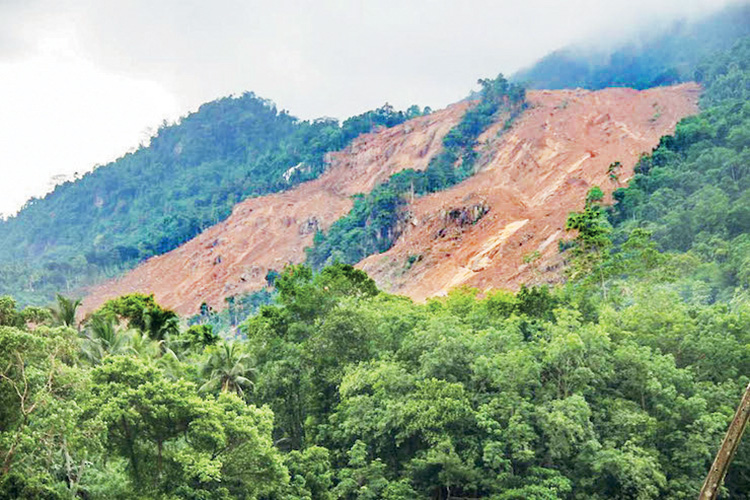
What Sri Lanka’s recent disasters tell us
Sri Lanka has always lived with the moods of the monsoon. For generations, people have grown used to seasonal rhythms of rain, wind and sunshine. Yet what the country has witnessed in recent months feels different. The storms have been stronger, the rainfall more intense, the destruction more widespread and the recovery more painful. The nation has been battered by floods, landslides and hurricane force winds that arrived with little warning and left thousands struggling to rebuild their lives. Scientists say this new pattern is not an accident of nature. It is a direct outcome of the world’s changing climate, which is heating the atmosphere and oceans and turning familiar weather cycles into something far more volatile.
To understand why Sri Lanka is experiencing such severe storms and flooding, it helps to begin with a simple idea. A warmer world holds more energy. When the atmosphere and ocean temperatures rise, they behave like an overheated engine. The monsoon winds strengthen. Rain clouds grow heavier. Sea levels climb. All these changes amplify the forces that produce extreme weather. What used to be occasional, manageable disasters are turning into regular and overwhelming events.
One of the clearest links between climate change and extreme weather is found in rising ocean temperatures. The Indian Ocean is warming faster than most other major bodies of water on the planet. This has serious consequences for Sri Lanka because the surrounding sea regulates the island’s climate. Warm oceans feed moisture into the atmosphere. This moisture then forms clouds that can trigger heavy downpours. When ocean temperatures climb beyond their normal range, the atmosphere becomes supercharged. Rain that once fell steadily over several days can now fall in a matter of hours. This explains why many parts of the country have witnessed sudden cloudbursts that turn roads into rivers and fields into lakes.
Warmer oceans also influence wind patterns. A heated sea surface disturbs air circulation, sometimes producing swirling systems that carry destructive winds and torrential rain. While full scale cyclones are less frequent in Sri Lanka than in parts of India or Bangladesh, the island is increasingly experiencing hybrid storms that bring cyclone like winds without being classified as named cyclones. These storms uproot trees, blow roofs off houses and knock down electricity lines, making post disaster life even harder for affected communities.
Another major factor behind Sri Lanka’s recent extreme weather is the shifting behaviour of the monsoon. For centuries, the island has relied on two monsoons that arrive at predictable times. Farmers, fishermen and traders built their lives around this rhythm. Climate change has disrupted this familiar pattern. The monsoons are becoming erratic. They may arrive later than usual or withdraw too early. In some years they bring too little rain, causing droughts. In other years they arrive with overwhelming intensity, bringing rain far beyond the land’s capacity to absorb. This unpredictability makes it difficult for people to prepare. It also increases the risk of disasters because infrastructure, agriculture and drainage systems were designed for a different climate.
In many regions of Sri Lanka, the land itself has become more vulnerable. Rising temperatures and unpredictable rainfall weaken soil structures. When long dry spells are followed by sudden downpours, the earth cannot hold together. Hillsides become unstable and landslides occur with devastating speed. Villages that once felt safe now face new threats as slopes collapse without warning. These disasters are not simply natural. They are intensified by human activities such as deforestation, poor land management and unplanned construction. Climate change acts as a catalyst, magnifying these risks and turning minor vulnerabilities into life threatening dangers.
The Sea level rise adds yet another layer of concern. The coasts of Sri Lanka are home to millions of people, as well as vital industries such as fishing, tourism and trade. Higher sea levels make coastal flooding far more common, especially when combined with storm surges. During recent storms, waves pushed much farther inland than usual, damaging homes, shops and fishing equipment. Saltwater intrusion also harms soil and freshwater supplies, threatening agriculture in coastal zones. With sea levels continuing to rise, these risks will only grow unless long term protective measures are put in place.
It is also important to recognise the human side of these disasters. Climate change is not only about shifting weather patterns. It is about the people who must confront the consequences. In the aftermath of the recent events, Sri Lankans have shown remarkable courage. Families have worked together to clear debris, rebuild houses, restore livelihoods and comfort those in distress. Yet the burden has not been evenly distributed. Low income households, informal settlements and rural communities often face the greatest hardships. Many of them live in areas more prone to flooding and landslides. They also have fewer resources to recover when disasters strike. Climate change therefore deepens existing inequalities, making vulnerable groups even more exposed.
Children are among the worst affected. Schools often close for days or weeks after floods, interrupting education and adding stress to families already struggling with upheaval. Health risks rise as stagnant water becomes a breeding ground for mosquito borne diseases. Malnutrition can worsen when livelihoods are disrupted and food prices increase. Elderly people face additional risks because they may have difficulty moving quickly during emergencies or accessing medical care after the disaster.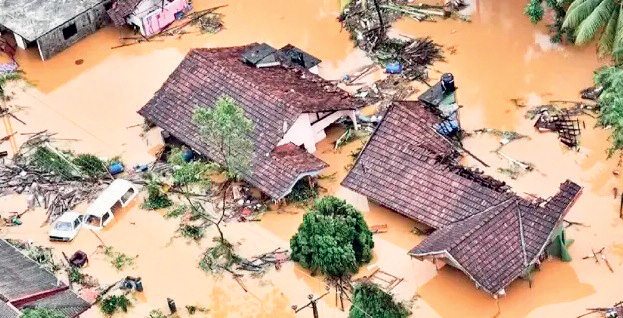
In cities, extreme weather strains essential services. Heavy rains overwhelm drainage systems, causing urban flooding that brings traffic to a halt and damages vehicles and businesses.
Hospitals face sudden influxes of patients. Water treatment plants struggle to maintain supply when rivers overflow or become contaminated. Power outages become common as strong winds damage transmission lines. These disruptions show how deeply interconnected human systems are with the natural environment. When the climate changes, every part of society feels the impact.
Despite the grim realities, there is reason for hope. Sri Lanka has a long history of resilience. Communities have rebuilt after countless storms, droughts and conflicts. Today the country has access to better technology, stronger scientific knowledge and more global support than ever before. What is needed is a clear commitment to prepare for the future rather than react only after disasters strike.
One of the most promising strategies is early warning systems. Accurate forecasts can save lives by giving people the time they need to move to safety. Sri Lanka has already improved its meteorological capabilities, but there is still room to strengthen local communication networks so that warnings reach everyone, including those in remote areas or without internet access. Community education is equally important. When people understand what climate change means for their region, they can make informed choices about housing, farming and water use.
Infrastructure must also evolve. Drainage systems in many towns need upgrading to handle more intense rainfall. Riverbanks require reinforcement to prevent flooding. New buildings, particularly in risk prone zones, must follow safety standards that take climate change into account rather than relying on outdated assumptions about weather patterns. At the same time, restoring natural ecosystems can offer powerful protection. Replanting mangroves, preserving wetlands and maintaining forest cover all help buffer the impact of floods, storms and landslides. Nature is one of the most effective defences against extreme weather when it is allowed to function properly.
On a broader level, Sri Lanka will benefit from global efforts to slow climate change. The island is a small emitter of greenhouse gases compared to many industrialised nations, yet it bears a heavy share of the consequences. International cooperation is essential to reduce harmful emissions, invest in renewable energy and support adaptation in vulnerable countries. Sri Lanka can also strengthen its energy security by expanding solar, wind and other sustainable sources, which reduce dependence on fossil fuels that contribute to climate change.
However, even as governments and scientists work on long term solutions, the experience of ordinary Sri Lankans during the recent storms offers an important lesson. Climate change is not a distant threat. It is happening now. It is felt in flooded living rooms, damaged paddy fields, broken bridges and displaced families. It reshapes the choices parents make for their children and the fears felt by those who live close to rivers or hillsides. It influences food prices, housing stability and health. It is a lived reality, not just an environmental problem.
At its heart, the story of Sri Lanka’s extreme weather is a story about people trying to protect their homes and loved ones. It shows how a global crisis can land with fierce intensity on a small island. But it also reveals the strength of human solidarity. Neighbours rescuing neighbours. Strangers offering food and shelter. Volunteers stepping into danger to help those trapped in rising waters. This spirit of care will be essential in the years ahead as the climate continues to warm and weather events become even more unpredictable.
There is no single solution that will shield Sri Lanka from every future storm. Yet there are many steps the country can take to reduce risk, strengthen communities and build resilience. These efforts will require resources, planning and political will. They will demand cooperation across regions, sectors and generations. Above all, they will require recognising that climate change is not someone else’s problem. It is a shared challenge that demands collective responsibility.
The recent disasters have served as a warning and a call to action. They have shown how quickly weather can turn violent and how deeply it can disrupt daily life. But they have also shown the urgency of preparing for a hotter and more unpredictable world. Sri Lanka has the knowledge and the capability to adapt. Its people have the determination. If these strengths are harnessed with foresight and compassion, the country can chart a safer path through the stormy decades ahead.
Climate change may be reshaping the monsoon, but it does not have to dictate Sri Lanka’s destiny. With the right choices, the island can remain not only a place of natural beauty but also a place of resilience, hope and human connection in the face of a changing planet.
(The writer is an environmentalist.)
by Vincent David ✍️
-
News4 days ago
Lunuwila tragedy not caused by those videoing Bell 212: SLAF
-

 News3 days ago
News3 days agoLevel III landslide early warning continue to be in force in the districts of Kandy, Kegalle, Kurunegala and Matale
-

 Latest News5 days ago
Latest News5 days agoLevel III landslide early warnings issued to the districts of Badulla, Kandy, Kegalle, Kurunegala, Matale and Nuwara-Eliya
-

 Features5 days ago
Features5 days agoDitwah: An unusual cyclone
-

 Latest News6 days ago
Latest News6 days agoUpdated Payment Instructions for Disaster Relief Contributions
-

 News1 day ago
News1 day agoA 6th Year Accolade: The Eternal Opulence of My Fair Lady
-

 Latest News6 days ago
Latest News6 days agoLandslide Early Warnings issued to the Districts of Badulla, Colombo, Gampaha, Kalutara, Kandy, Kegalle, Kurunegala, Matale, Moneragala, Nuwara Eliya and Ratnapura
-

 News1 day ago
News1 day agoCPC delegation meets JVP for talks on disaster response

